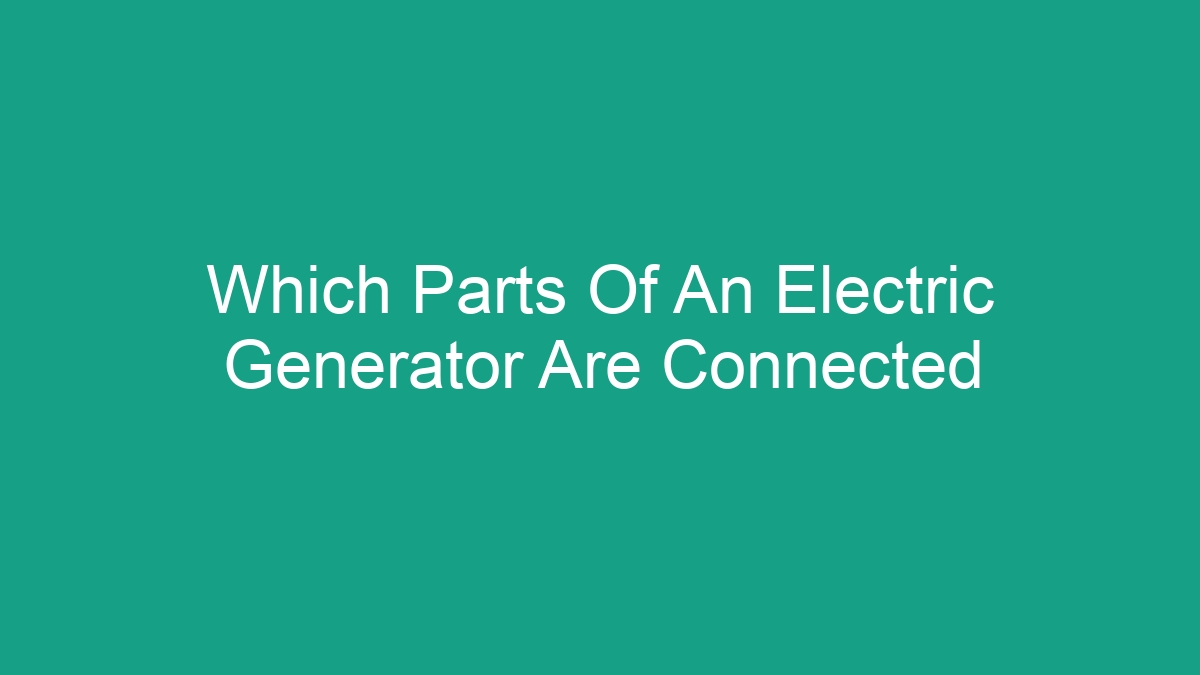
Introduction
An electric generator is a device that converts mechanical energy into electrical energy. It consists of several interconnected parts that work together to generate electricity. Understanding which parts of an electric generator are connected is crucial for its proper functioning and maintenance.
In this article, we will explore the different components of an electric generator and how they are connected to each other. We will also discuss the importance of these connections and provide insights into the operation of an electric generator.
1. Engine/Prime Mover
The engine or prime mover is the component of the generator that provides the mechanical energy needed to drive the generator. This could be a diesel engine, gasoline engine, natural gas engine, or even a steam turbine. The engine is connected to the generator through a drive shaft or coupling. It is essential to ensure that the engine is properly connected to the generator to ensure efficient energy conversion.
2. Rotor and Stator
The rotor and stator are the primary components of the generator where the actual electricity generation takes place. The rotor is the rotating part of the generator, while the stator is the stationary part. The rotor is connected to the engine through the drive shaft and spins within the stator, creating a magnetic field. The stator is connected to the electrical load through the generator’s output terminals.
Connections:
– The rotor is connected to the engine via the drive shaft or coupling.
– The stator is connected to the electrical load through the output terminals.
3. Voltage Regulator
The voltage regulator is an essential component of the generator that controls the output voltage produced by the generator. It ensures that the voltage remains within the specified range, regardless of the load or engine speed. The voltage regulator is typically connected to the generator’s stator windings and controls the excitation current to the rotor to maintain a constant output voltage.
Connections:
– The voltage regulator is connected to the stator windings of the generator.
– It is also connected to the rotor to control excitation current.
4. Control Panel and Instrumentation
The control panel and instrumentation of the generator provide the operator with essential information about the generator’s status and allow for manual control of various parameters. The control panel is connected to the engine, voltage regulator, and other components to monitor and regulate the generator’s operation.
Connections:
– The control panel is connected to the engine for monitoring and control.
– It is also connected to the voltage regulator and other components for data acquisition and control.
5. Cooling System
The cooling system of the generator is crucial for dissipating the heat generated during operation. It typically consists of a radiator, cooling fan, and associated piping. The cooling system is connected to the engine to regulate its operating temperature and prevent overheating.
Connections:
– The cooling system is connected to the engine to regulate its temperature.
– It may also be connected to the generator’s stator and rotor for cooling purposes.
6. Fuel System
The fuel system is responsible for supplying the engine with the necessary fuel for combustion. This includes fuel tanks, fuel pumps, filters, and injectors. The fuel system is connected to the engine to deliver a continuous supply of fuel during operation.
Connections:
– The fuel tanks are connected to the engine through fuel lines.
– The fuel pumps and injectors are connected to the engine’s combustion chamber for fuel delivery.
7. Exhaust System
The exhaust system removes the combustion gases produced by the engine during operation. It typically includes an exhaust manifold, muffler, and exhaust piping. The exhaust system is connected to the engine to expel the gases safely away from the generator.
Connections:
– The exhaust manifold is connected to the engine’s exhaust ports.
– The exhaust piping is connected to the muffler and external exhaust outlet.
In conclusion, an electric generator consists of multiple interconnected parts that work together to generate electricity. Understanding how these components are connected is essential for the proper functioning and maintenance of the generator.
FAQs (Frequently Asked Questions)
Q: Can I connect a generator directly to my home’s electrical system?
A: It is essential to use a transfer switch to connect a generator to your home’s electrical system to ensure safety and prevent backfeeding.
Q: What maintenance is required for the connections of an electric generator?
A: Regular inspection of the connections, including tightening bolts and checking for signs of wear, is essential for maintaining the proper functioning of the generator.
Q: How can I ensure the proper connections of an electric generator?
A: It is recommended to consult the manufacturer’s instructions and seek professional assistance to ensure the proper installation and connections of an electric generator.
Q: Can I upgrade the connections of my existing generator?
A: Upgrading the connections of a generator may be possible, depending on the specific model and components. It is best to consult with a qualified technician for advice on upgrading generator connections.
Q: What safety precautions should I take when working with generator connections?
A: Always follow the manufacturer’s safety guidelines and disconnect the generator from power sources before inspecting or working on its connections. Additionally, ensure that all connections are made securely to prevent electrical hazards.



